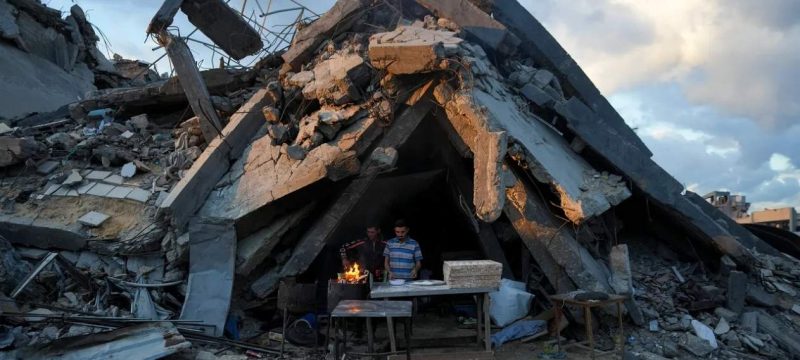As thousands of displaced Palestinians return to their neighborhoods after the ceasefire, the harsh reality of Gaza’s devastation is impossible to ignore. Entire communities have been reduced to rubble, with homes, schools, hospitals, and infrastructure obliterated during months of conflict. The estimated cost of Gaza reconstruction now exceeds $70 billion, according to UN figures — a staggering amount that underscores the enormity of the challenge ahead.
Experts warn that rebuilding Gaza will be far more complex than starting from scratch. “You aren’t starting in the sand, you are starting with rubble,” said Prof. Andreas Krieg, a Middle East security expert from King’s College London. Satellite assessments indicate that around 84% of the Gaza Strip has been destroyed, with some areas like Gaza City suffering damage as high as 92%.
The destruction has left behind more than 60 million tonnes of debris, much of it contaminated with unexploded ordnance and human remains. Clearing this rubble will be the first and most critical step in the Gaza reconstruction process. Former JCB executive Philip Bouverat explained that the debris must be carefully sorted and crushed for reuse, but progress depends on restoring safe access and importing heavy equipment.
“We first need a deep-water port to bring in thousands of container-loads of materials,” Bouverat emphasized. “Only then can rebuilding begin.”
Water and Sanitation Crisis
Water and sanitation infrastructure in Gaza has suffered near-total collapse. UNICEF reports that over 70% of water and sewage facilities have been damaged or destroyed since October 2023. Israeli operations left multiple treatment plants in ruins, including the Sheikh Ejleen wastewater facility, where satellite imagery shows severe fire damage.
Maher Najjar, deputy director of Gaza’s Coastal Municipalities Water Utility (CMWU), confirmed that all six wastewater treatment plants are damaged. Repairs have been repeatedly interrupted by fresh airstrikes and a lack of materials. “We need at least $50 million just to restore 20% of services,” he said, adding that total losses exceed $1 billion.
Without functioning plants, disease outbreaks have surged, with doctors reporting high rates of diarrhea and risk of cholera among children. Access to clean water remains one of Gaza’s most urgent humanitarian priorities.
Housing and Infrastructure
Housing destruction across Gaza is catastrophic. According to UNOSAT, more than 282,000 homes have been damaged or flattened — a figure that continues to rise. In Sheikh Radwan, once a vibrant neighborhood, satellite imagery shows entire blocks erased after heavy bombardment.
RAND Corporation researcher Shelly Culbertson warns that rebuilding housing could take decades. “If reconstruction proceeds at the same pace as in 2014 and 2021, it could take 80 years,” she said. However, improved planning — such as designing temporary camps that evolve into permanent neighborhoods — could accelerate progress.
Electricity and Power Supply
The war has also plunged Gaza into near-total darkness. Since October 2023, Israeli authorities have repeatedly cut power lines, leaving millions without electricity. The Gaza Power Plant remains inoperable due to fuel shortages, and 80% of generation and distribution assets are destroyed, valued at $494 million in damages.
Gedco, Gaza’s power distribution company, reported that 70% of its facilities have been destroyed. Makeshift solar panels and diesel generators now power hospitals and tent settlements, offering only minimal relief. Restoring power will be essential for hospitals, schools, and future rebuilding efforts.
Agriculture and Food Security
The war has devastated Gaza’s agricultural lands, long considered the lifeline of local communities. Satellite data shows 82% of annual crops and 97% of tree crops — including olive and citrus groves — wiped out. Roads carved by tanks and bomb craters have made farmlands unusable.
Kent State University’s Prof. He Yin attributes the destruction to “razing, heavy vehicle activity, bombing, and shelling.” Former JCB executive Bouverat noted that before agriculture can resume, the land must be cleared of unexploded bombs and mines. “If Gazans can grow their own crops, they can feed themselves again,” he said.
Education and the Next Generation
With nearly half of Gaza’s population under 18, education is critical for long-term recovery. Yet, the UN agency UNRWA reports that over 91% of schools are damaged or destroyed. Many school buildings were repurposed as shelters during the conflict, later targeted by Israeli forces.
Higher education institutions have also been obliterated. In December 2023, Al-Azhar University and Israa University were both demolished by Israeli troops after being occupied as temporary bases. The scale of loss threatens to disrupt education for an entire generation of young Palestinians.
A Long Road Ahead
The monumental task of Gaza reconstruction will require international cooperation, funding, and political stability. From clearing debris to restoring water, power, and education, every step is interlinked. The process may take decades, but rebuilding Gaza represents not just the reconstruction of infrastructure — it is the rebuilding of lives, hope, and humanity.
In other news also read about The Secret Hands Behind Gaza’s Hostage Exchanges









